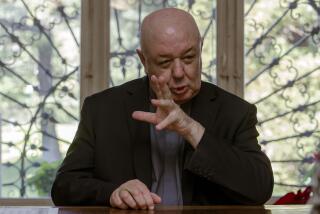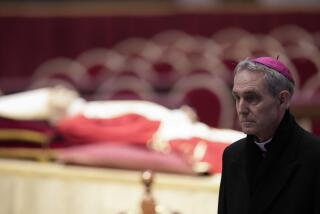U.S. Scholar Suspected in Theft of Manuscript Pages : Vatican: Tome owned by medieval poet Petrarch has been cut up. Art historian’s lawyer denies client did it.
- Share via
VATICAN CITY — The binding is frayed brown leather. The Latin contents were copied painstakingly in black ink and illuminated with brilliant miniatures around the year 1300. The margins are annotated by one of history’s great poets.
For more than a century, the volume once owned by Petrarch has been a jewel in the Vatican Library, available for study only by experts. But one of them may have cheated: A modern scholar-vandal has apparently savaged the work.
“It looks like the theft was done in haste and with a penknife,” Father Leonard E. Boyle, the grieving Vatican Library director, said Wednesday, fingering the damaged parchment where three double-sided pages had been crudely cut out by someone with a yen for aesthetic larceny.
While Boyle, who is Canadian, lamented, researchers combed the world’s largest collection of ancient manuscripts Wednesday for more damaged volumes and missing pages, or folios, as they are known.
Boyle said they concentrated on works known to have been studied by a trusted old friend of the library: Anthony Melnikas, a distinguished art professor at Ohio State University.
According to Boyle, earlier this month Melnikas showed two folios from the volume to a manuscript dealer in Akron, Ohio. Suspicious about where they could have come from, the dealer, Bruce Ferrini, consulted James H. Marrow, an art historian at Princeton University.
“Marrow found a 1973 magazine article in which the volume was featured and sent a fax asking me to check folios 98 and 140. They had been cut out; so had folio 114,” said Boyle, a Dominican priest who is himself an eminent scholar of medieval manuscripts and prefect of a library where 150,000 of them reside.
Subsequently, Boyle said, the U.S. Customs Service in Cleveland informed him that it now has three folios from the Petrarch book, which the library catalogues as Vaticani Latini 2913 and contains works on agriculture, military strategy and monastic life by Romans writing in the first centuries after the death of Christ.
Vatican specialists are uncertain if the manuscript was assembled for Petrarch, a poet many consider the father of the Italian Renaissance, or if he simply bought it in 14th-Century Italy. Boyle suspects that the manuscript may be the work of scribes at the University of Paris around 1300.
One of the folios slashed from the manuscript contains an exquisite miniature of a farmer threshing grain. Two folios were turned over to customs by the dealer, the third by Melnikas, Boyle said.
“Customs also apparently has a fourth folio, but it’s not from this manuscript. We don’t know where it is from,” Boyle said.
Once the folio theft was established, Vatican archivists studied request slips signed by every scholar who had examined the volume since 1887.
Melnikas, a 68-year-old manuscript specialist with decades of close association with the library, studied the manuscript on July 27, 1987. About 10 readers have studied it since, but Boyle said they would not have noticed missing folios unless they were looking for them.
Once Ferrini saw the reader list he called Boyle to say, “ ‘The man who showed me the folios is better known to you than to me,’ ” Boyle said.
No charges have been brought against Melnikas, who has been questioned by customs investigators. He is not speaking with reporters, his lawyer James E. Phillips said by phone Wednesday from Columbus, Ohio.
“Prof. Melnikas did not intend to deprive the Vatican of any property. He denies cutting anything out of anywhere. I can’t get into how the material may have come into his possession,” Phillips said.
Melnikas, a native of Lithuania, emigrated to the United States in 1950, studied art in Italy, was awarded a doctorate in art history by the University of Michigan and planned to retire this year from Ohio State.
Vatican manuscripts are closely held; not even the library staff has full access. An outsider needs a formidable academic pedigree and explicit need for documents that cannot be found elsewhere before the prickly Boyle will authorize access.
Well known and well liked by staff and directors at the library, where he appears to have last worked in 1993, Melnikas was one of a handful of eminent scholars authorized to work there in summer weeks when staff and supervision is reduced and the archives are nominally closed, Boyle said.
In a cupboard in Boyle’s office sits a stunning three-volume, $1,250-per-set study of miniatures in manuscripts containing the Decretum Gratiani, the 12th-Century decree by the Camaldolese monk Gratian that established canon law. Melnikas’ co-author for that study, described as “at once definitive and innovative,” was Austrian Cardinal Alfons M. Stickler, who preceded Boyle as prefect at the library.
On Wednesday, Boyle said, Vatican researchers were examining the 20 bulky manuscripts cited in the bibliography of the three volumes, hoping they were intact.
More to Read
Sign up for Essential California
The most important California stories and recommendations in your inbox every morning.
You may occasionally receive promotional content from the Los Angeles Times.













